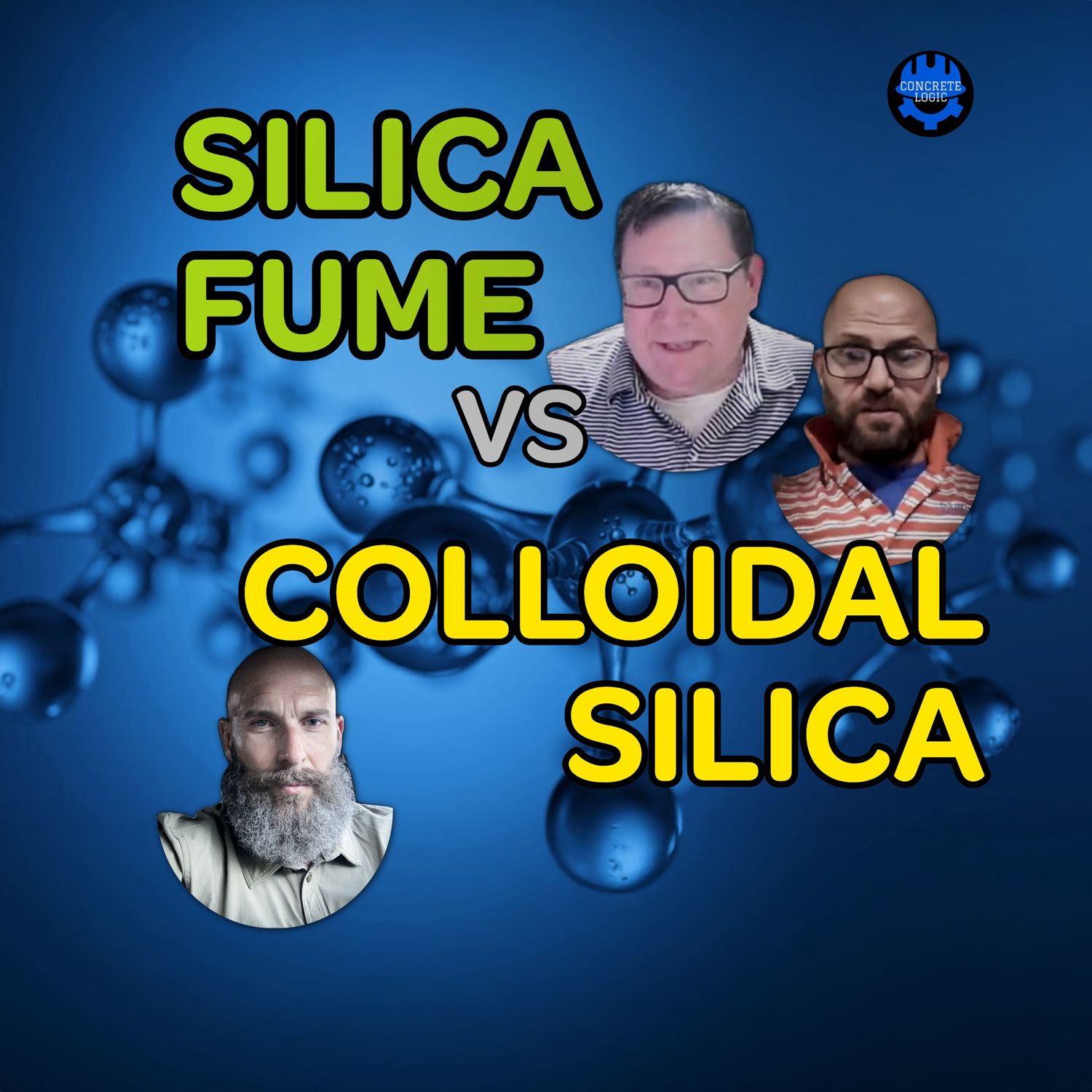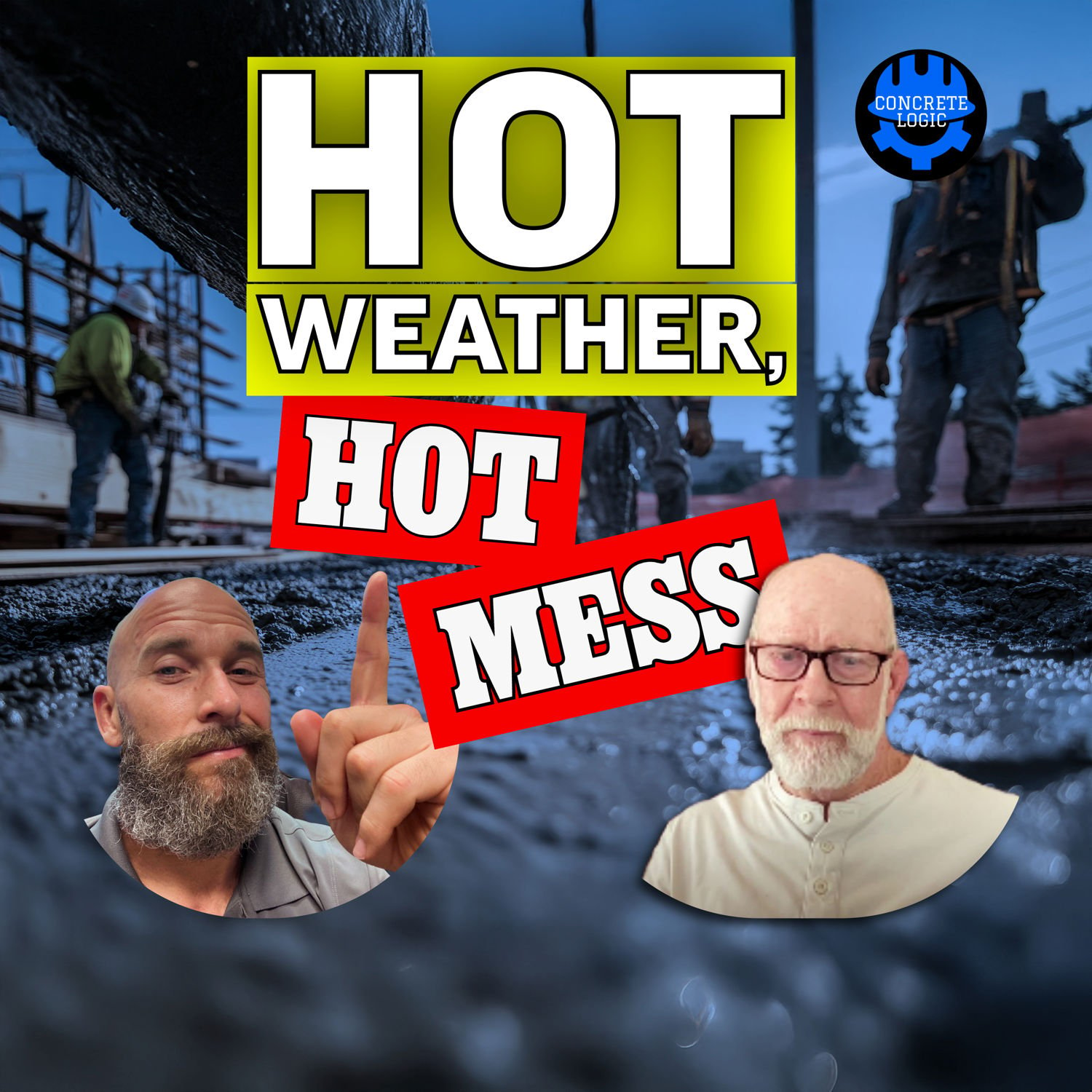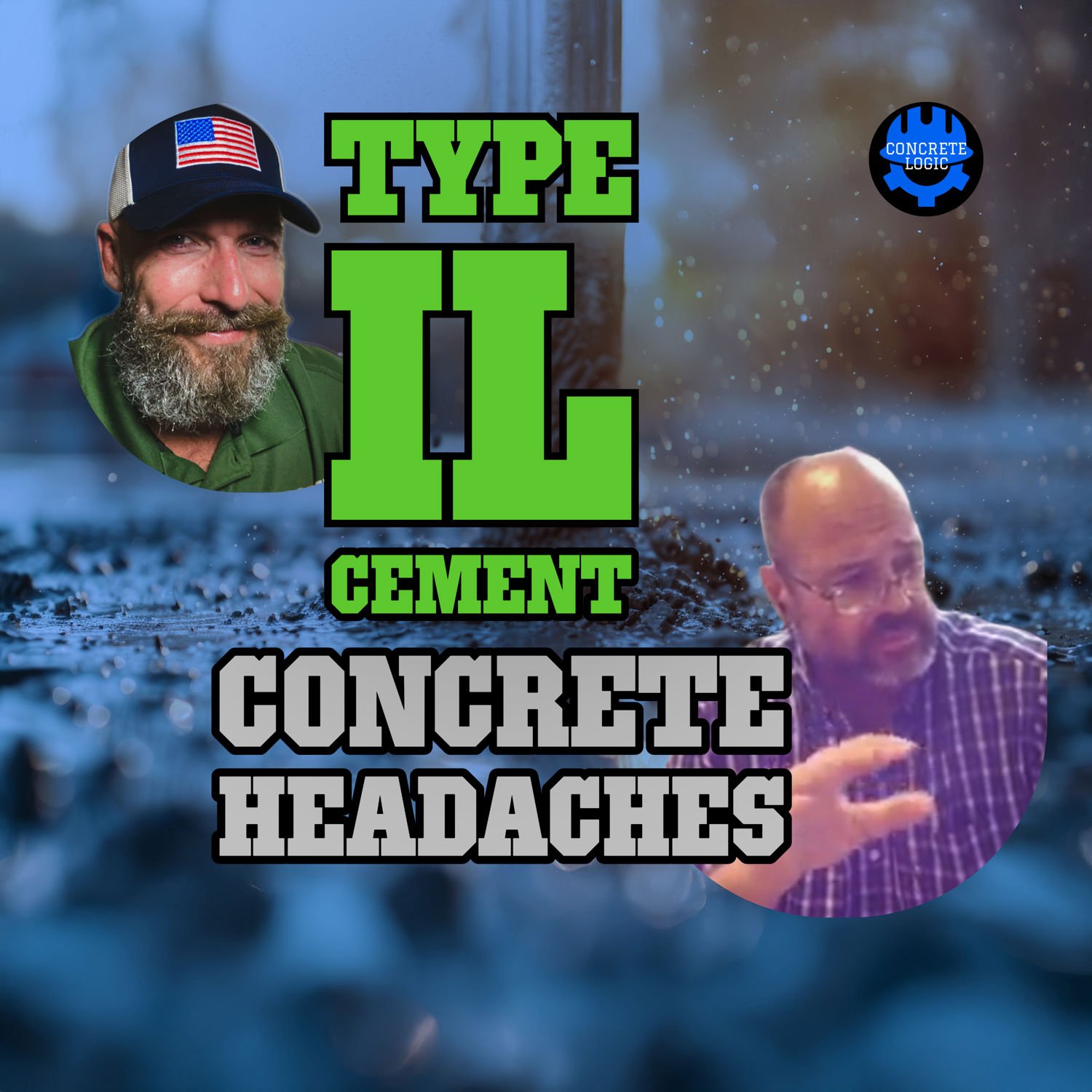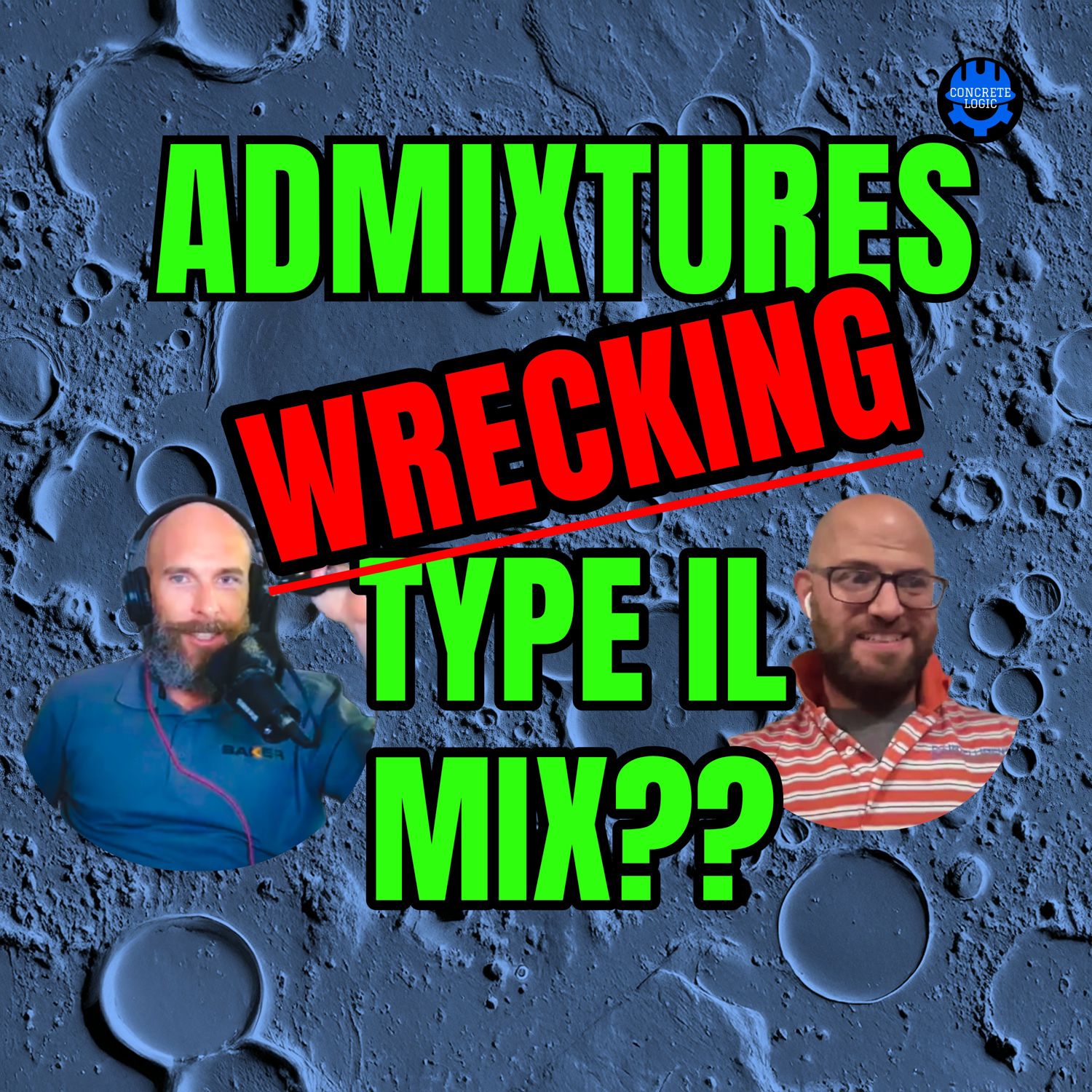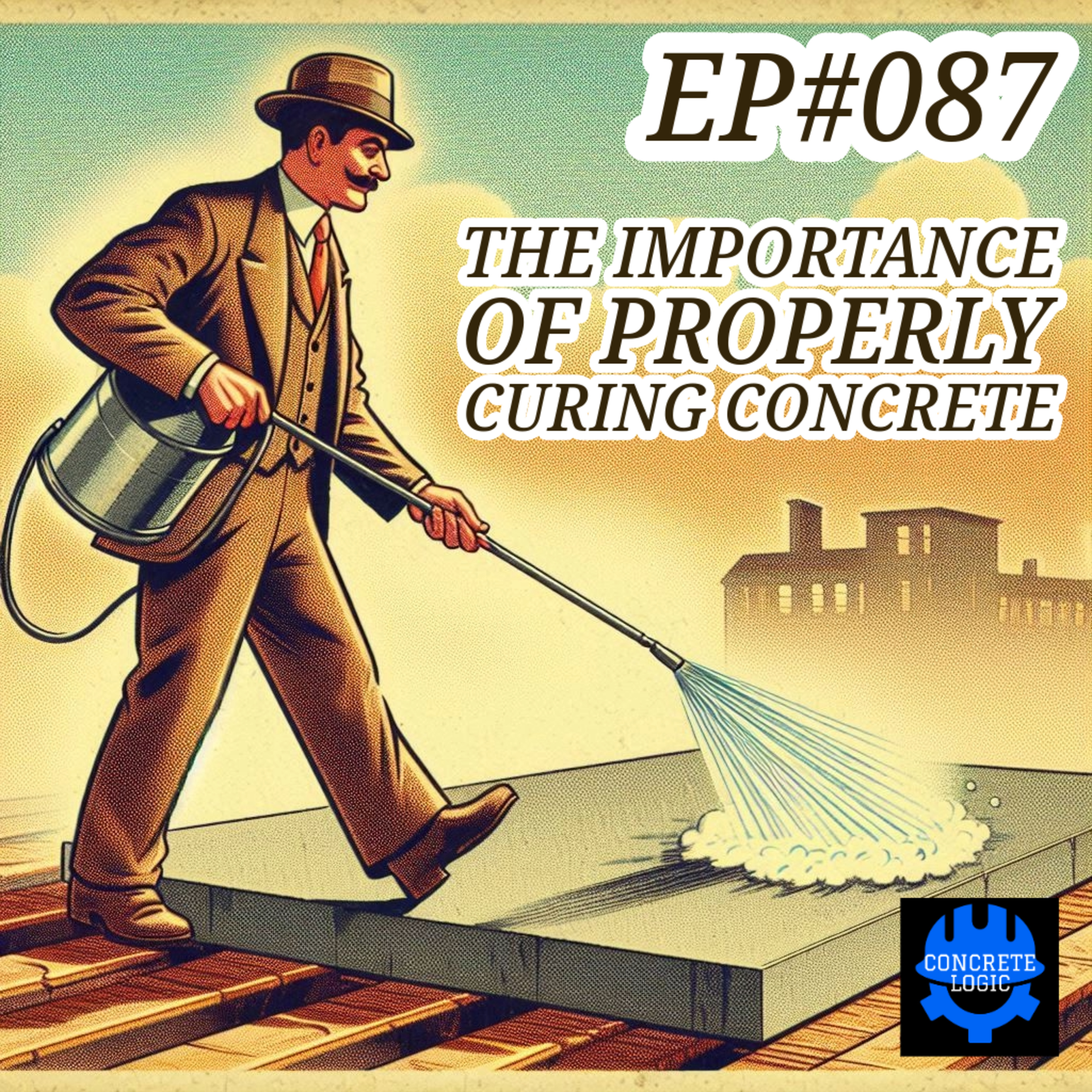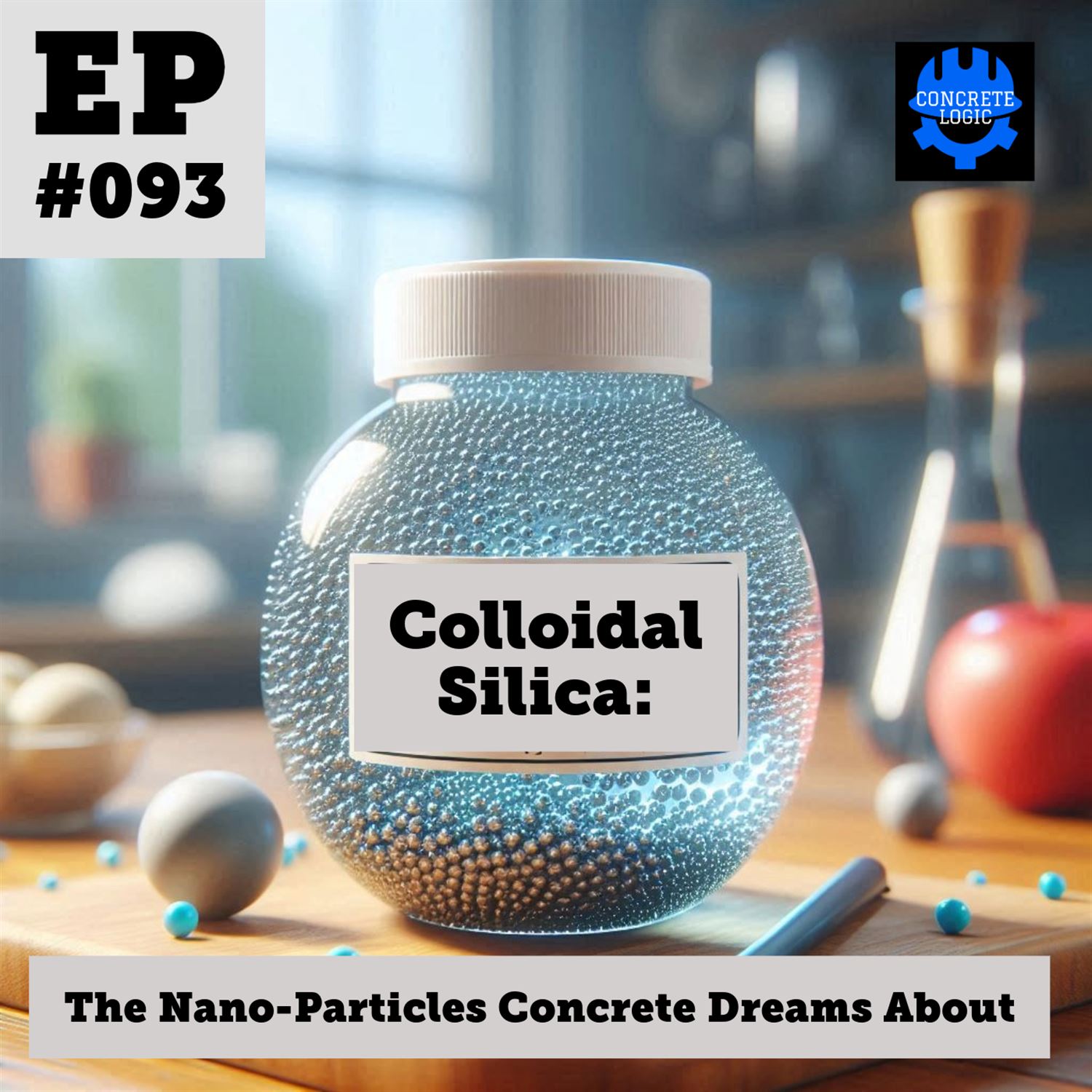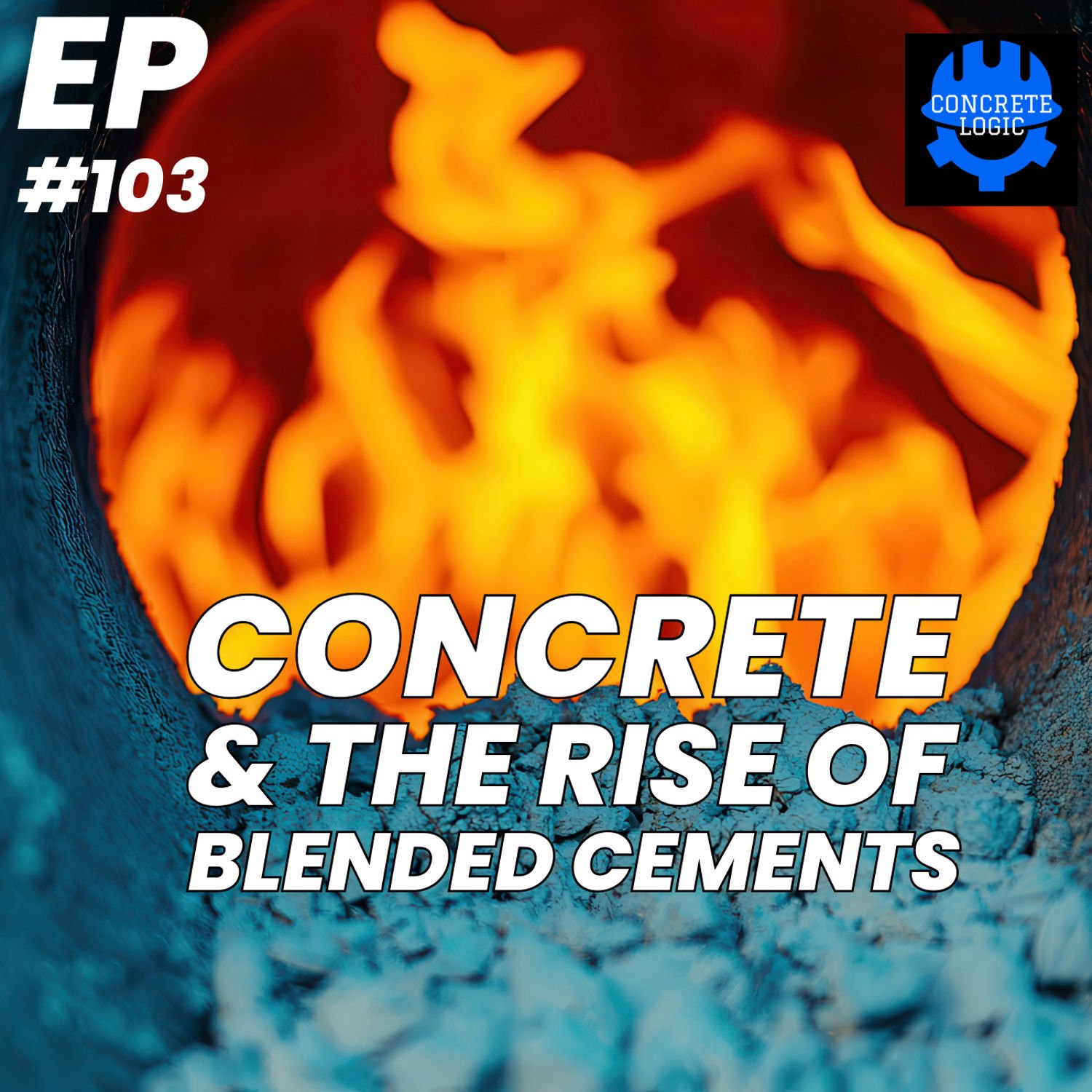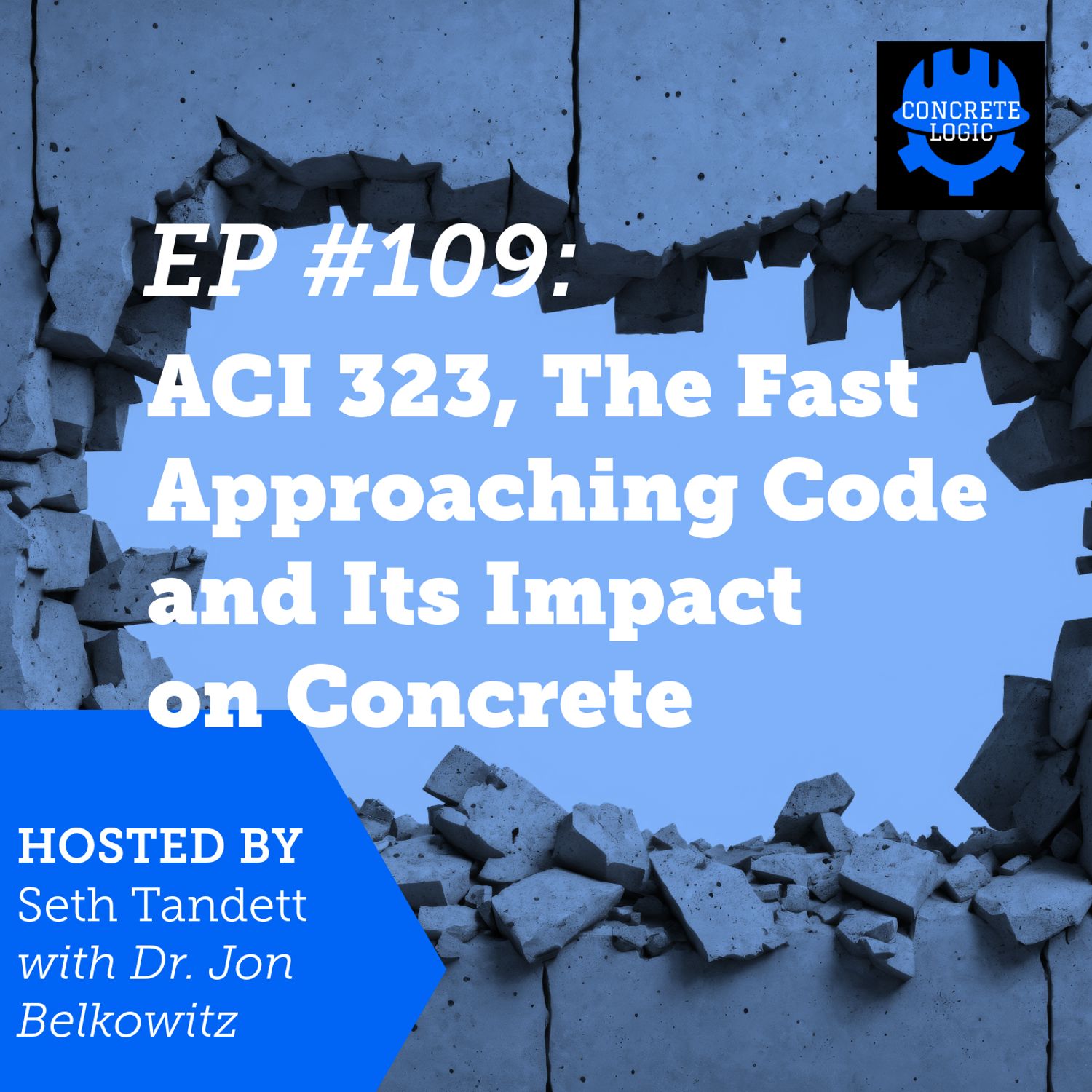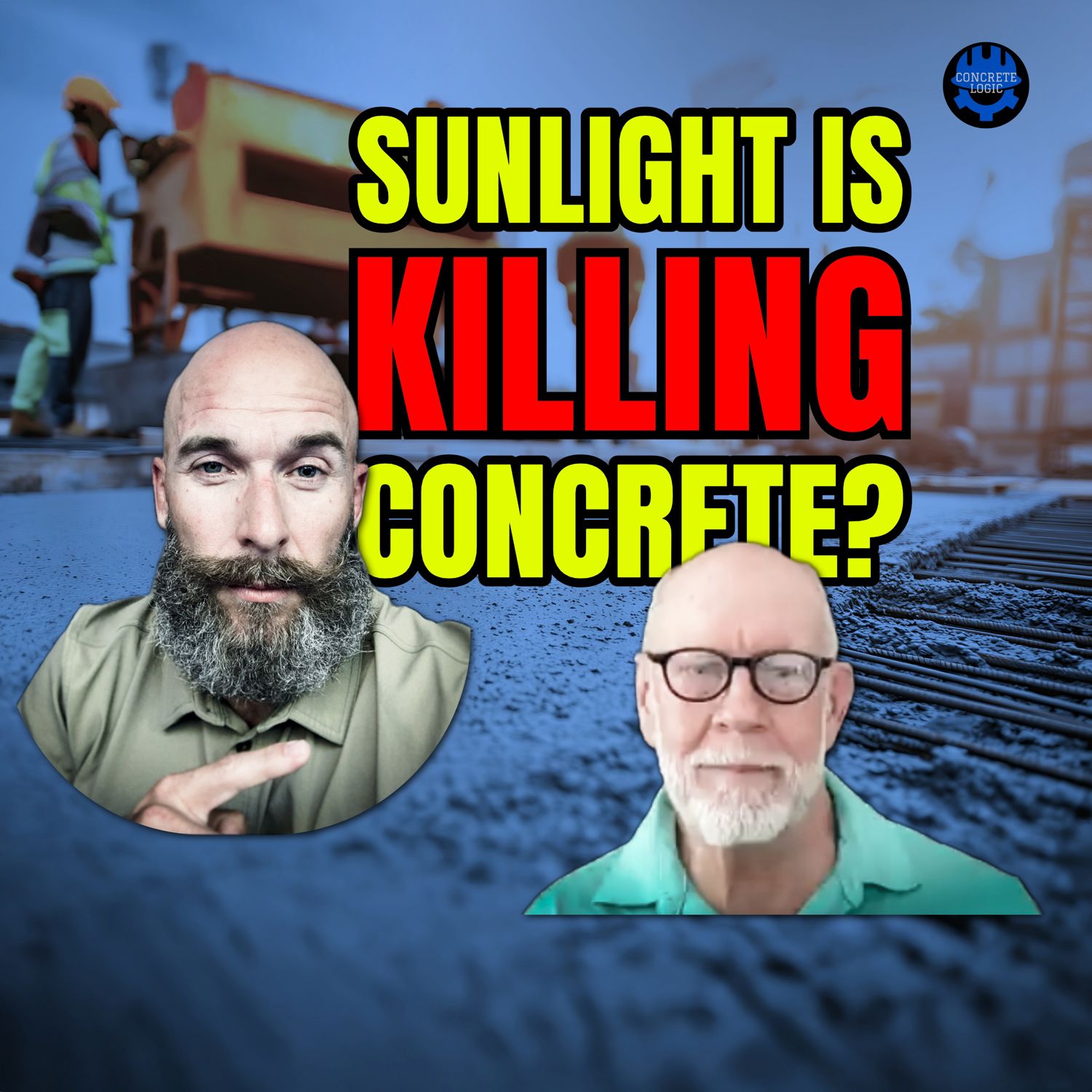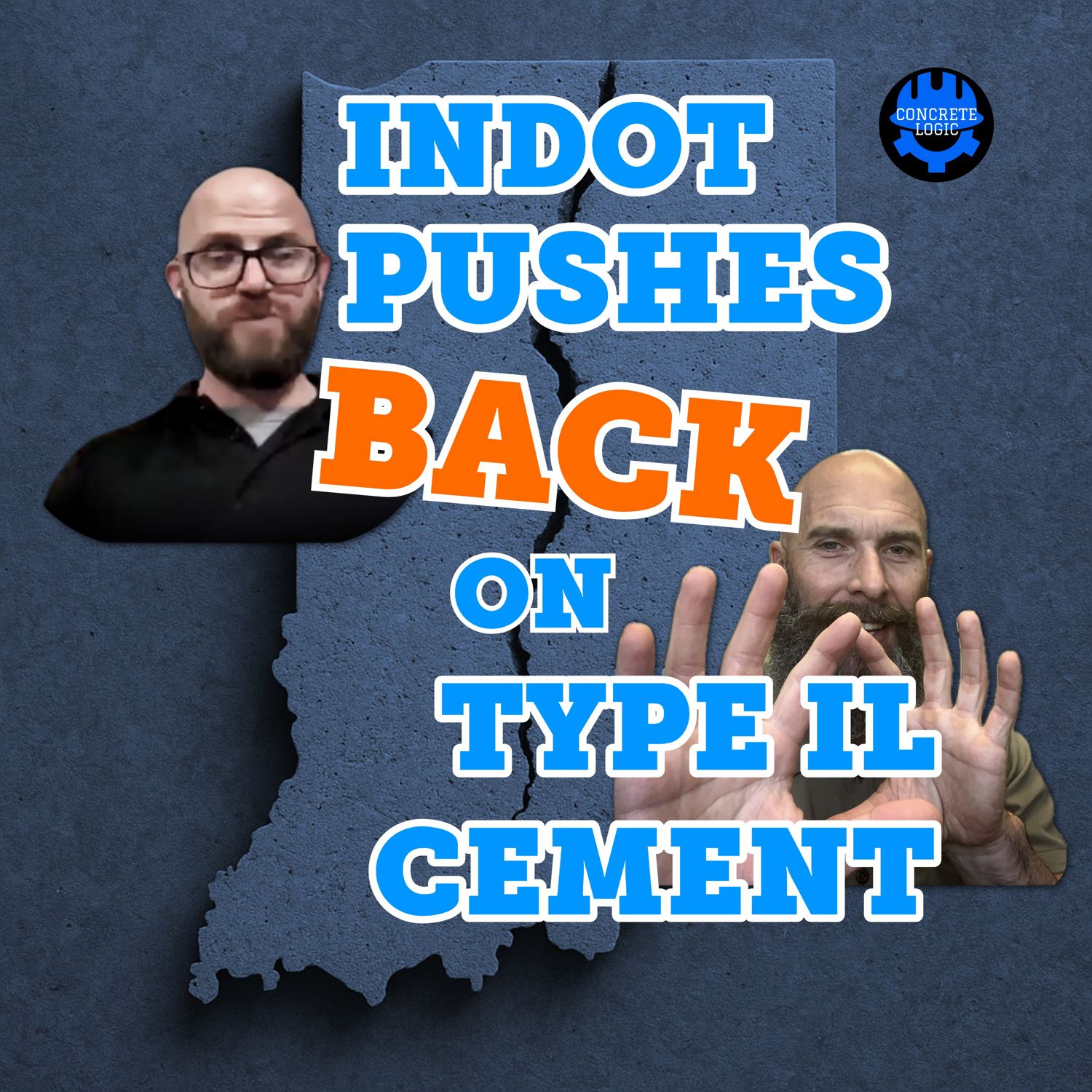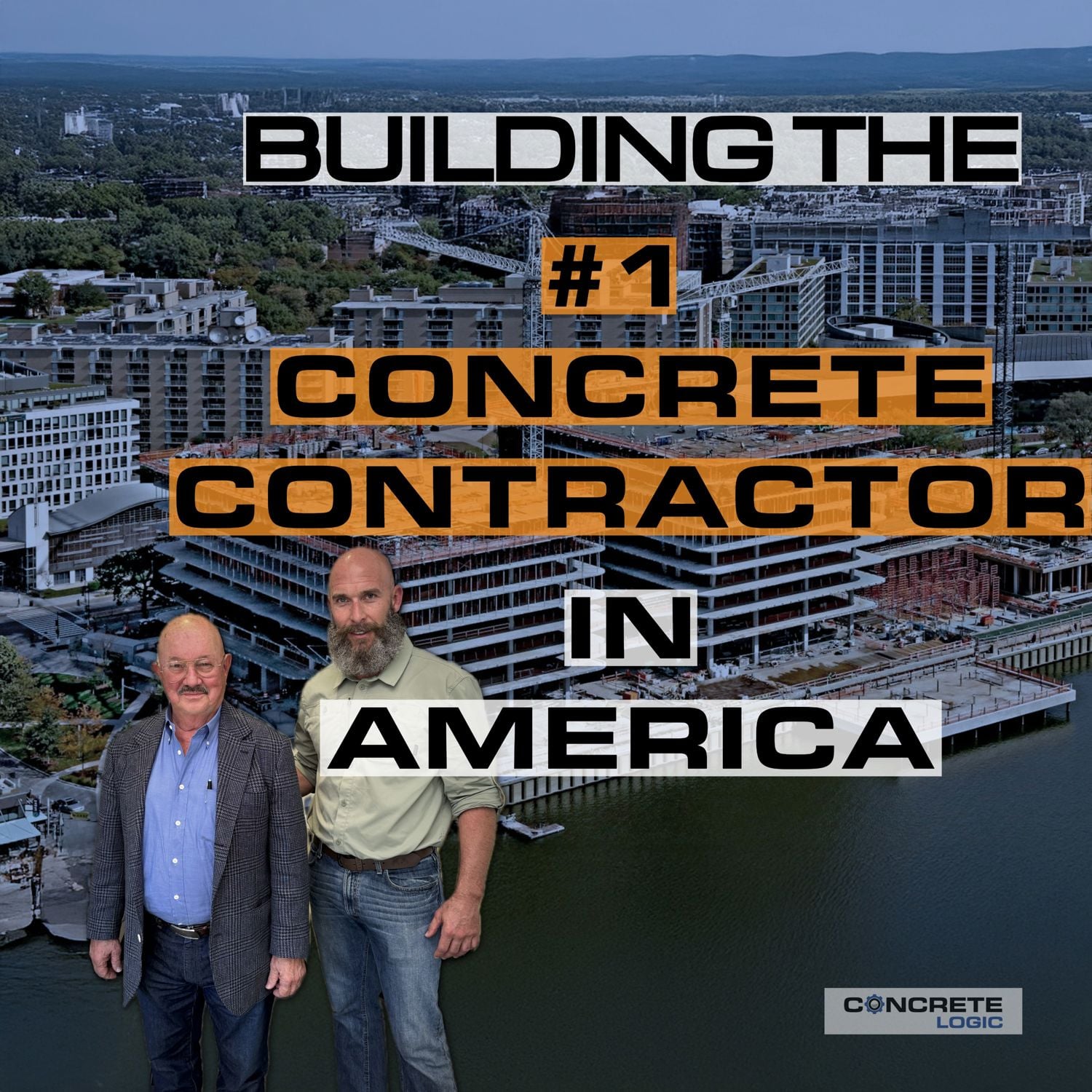EP #112: Ultra High-Performance Concrete - Beyond Bridges
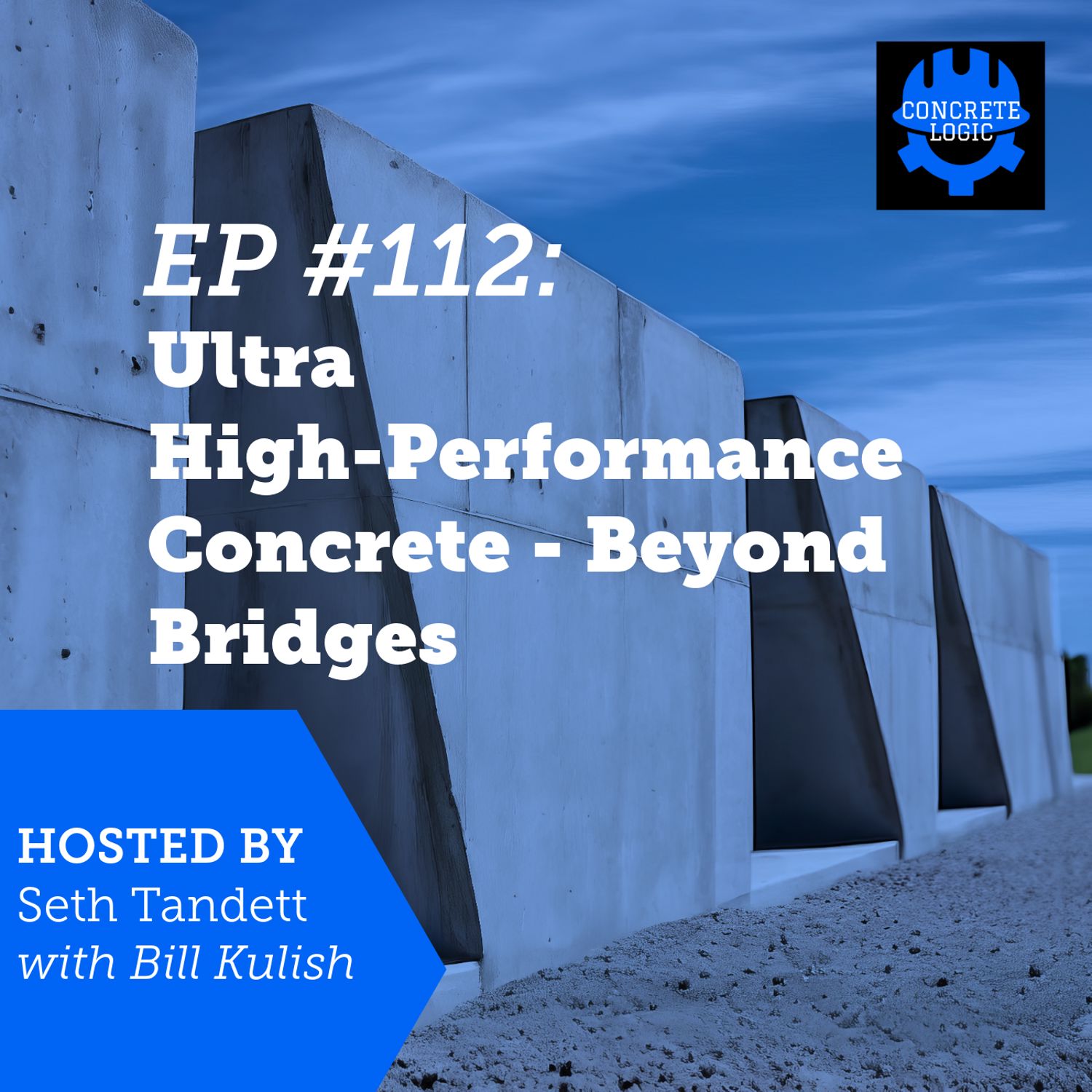
In this episode of the Concrete Logic Podcast, Seth Tandett and Bill Kulish delve into the world of Ultra High-Performance Concrete (UHPC). They discuss its unique properties, applications in infrastructure, and the value it brings despite its higher initial cost. The conversation also covers recent testing of UHPC against various projectiles, showcasing its impressive resistance and potential uses in safety applications. Additionally, they address the challenges faced in implementing UHPC standards and the need for ongoing discussions in the industry.
Takeaways
- UHPC is not traditional concrete; it has unique properties.
- The initial cost of UHPC is higher, but it offers long-term savings.
- Healthy discussions about standards and practices are essential.
- UHPC can significantly reduce the carbon footprint over time.
- The material is waterproof and salt-proof, enhancing durability.
- Testing against projectiles shows UHPC's impressive resistance.
- Value should be emphasized over cost when discussing UHPC.
- Real-world applications of UHPC can save time and resources.
- Collaboration and communication in the industry are crucial for progress.
Chapters
00:00 Introduction to Ultra High-Performance Concrete
02:50 Understanding UHPC: Composition and Properties
06:00 The Value Proposition of UHPC
08:55 Real-World Applications of UHPC
11:59 Testing and Validation of UHPC
15:06 Ballistic Testing and Performance of UHPC
26:00 Understanding NIJ Standards and Testing Protocols
28:58 Performance Metrics of UHPC in Ballistic Testing
33:58 Exploring Potential Applications of UHPC
37:56 Challenges in Concrete Testing and Standards
***
Did you learn something from this episode? Would you like to support the concrete industry's favorite podcast?
If so, donate at https://www.concretelogicpodcast.com/support/ .
When YOU donate to the show, you will be listed as a producer of the next episode that is released!
Join the Concrete Logic Academy! Enhance your learning from our podcast with engaging quizzes that test your knowledge and help you earn Professional Development Hours (PDHs). Support Concrete Logic and take your education to the next level! 🚀
FIND OUT MORE HERE: https://www.concretelogicacademy.com/
***
Episode References
Guest: Bill Kulish | Steelike, Inc. | bill@steelike.com
Guest Website: https://steelike.com/
Producers: Zac Richardson, Maya Richardson, Tom Cummings, Jodi Tandett
Donate & Become a Producer: https://www.concretelogicpodcast.com/support/
Music: Mike Dunton | https://www.mikeduntonmusic.com | mikeduntonmusic@gmail.com | Instagram @Mike_Dunton
Host: Seth Tandett, seth@concretelogicpodcast.com
Host LinkedIn: https://www.linkedin.com/in/seth-tandett/
Website: https://www.concretelogicpodcast.com/
LinkedIn: https://www.linkedin.com/company/concrete-logic-podcast
Why join the Concrete Logic Academy?
You get access to:
- Hands-On Video Courses
- Live Q&A Sessions
- Collaborative Projects
- Live Podcast Recordings
- Concrete Library
- Professional Development Hours (PDHs)
Learn more: https://www.concretelogicacademy.com/
Seth Tandett (00:02.87)
All right, welcome to another episode of the Concrete Logic Podcast. And today I have Bill Kulish from Steelike with me. And when we have Bill on, we talk about ultra high performance concrete or composite, whatever, however Bill wants to explain it today. So we're going to talk about that today. And as always, I just want to remind you how you can support the show.
You can do three or four or all of them or one of them or any of them. But the first thing you could do is if you enjoy the podcast, please share it. Get the word out there. So share it on any of the platforms you can listen to the podcast on. Other, I don't really like Apple. So I do these album arts. I don't know if people notice them or not, but the one that I released this week,
The the album art didn't come across on Apple and I checked the other ones The other platforms and they came across so I don't know Apple you're screwing up So that's the first way share second way is if you go to the concrete logic podcast calm Homepage There is a couple ways to get a hold of me
There's a contact linked at the top you click on that and then window opens up and it's like leaving me a email So you go on there and type in there and then on the bottom right hand corner. There's a microphone Little symbol thing you click on that and it lets you record on your computer a voicemail and what I like to get from you is topic or guest suggestions
So if there's somebody you want me to talk to on the podcast or there's a topic that you want us to talk about on the podcast Please reach out. Let me know Those are those are those first two things are really a big deal. So it helps the podcast immensely And then the third way is there's a donation button It's in the top right hand corner of the again ww.concrete logic podcast comm
Seth Tandett (02:20.974)
You can click on that and you can give any dollar amount of I've had folks reach out they get you know, they give ten bucks They give you know, twenty bucks. I've had someone give me six hundred bucks, which was great any amount is appreciated and that just helps pay for the equipment the the the this interface that we use we use Riverside it pays for that it pays for
There's some other things that we do as far as editing and other things. So it helps pay for all those things. But the deal is I put these podcasts out there for free, because I don't want to charge folks to educate themselves about concrete. think it's very important. So that's why I put it out there for free. And if you think there's some value out of that, you have an option there to do that. But again,
Appreciate all the support I've had so far coming up on three years of the podcast. And 100, this is we're recording episode 112 right now with Bill. So it's been a good journey so far. Bill, let's talk about ultra high performance composite or concrete. today, well, past episodes we talked about the bridge application.
for UHPC. So I think where we should start off is if you could explain again what UHPC is, how it's different from traditional concrete, if we can start there and then we can talk about those new applications that you wanted to discuss today.
Bill Kulish Steelike UHPC (04:09.154)
Sure. Good morning, Seth. Thanks for having me on. always, always a pleasure to be on this side of the camera and then to watch you on your many other podcasts. I learn every time. It's great also to see challenging standards and Dr. John expressing his opinion, qualified opinion. So thank you for that. UHPC, I'll do the hot. Yeah.
Seth Tandett (04:30.67)
Yeah, I don't want to interrupt you, but I think you just hit on something important here and that's kind of the purpose of this podcast is ACI. They put out the standards and now codes. They like the word code now. They put those out for us, for the industry. They have their own podcast. You should go listen to their podcast. I forgot the lady that does their podcast, but you can listen to it.
promise you is they won't go on there and probably critique their own standards or codes on their podcast. That would seem like that would be shooting themselves in the foot because they sell you. We all have to buy their standards and codes to read them and if they say, they're critiquing them. don't know. Maybe they will. Maybe I'm wrong. But that's kind of the purpose here.
Folks is for people to come on here and let's talk about things that I hear I hear when I talk to people offline Complain about things or say hey, we should try doing these things or These are my challenges and I wish You know this group or that group would help help out with these things. That's what the podcast is for so when you go to my the the website and you're
And you're sending me topic and guest suggestions. Don't hold back. Just tell me what you want to talk about and what you want to hear. because I think what Bill just said is, you know, that it's important for us to talk about these things and it's not like we, we dislike or, hate or, are negative about those things. I don't, I don't need that on the podcast, but I think we need healthy discussions and debates about things, that,
Bill Kulish Steelike UHPC (06:00.227)
Yep.
Seth Tandett (06:27.0)
that are shaping our industry. And if we don't talk about them and we don't discuss them or debate about them, there's people that don't know squat about concrete that are gonna dictate the concrete we get. And then you get, I mean we're already dealing with that kinda now, so we all need a voice, what we see out there, what's,
not just the bad things too, we need to talk about the successful things. Sorry Bill, I'm off my soap box now, you can go.
Bill Kulish Steelike UHPC (07:02.065)
No, I digress off your digression. So quick example is 1L, right? It's just a one-to-one throw it in there. Nobody own. Let's reduce carbon footprint. Meanwhile, we may be producing material that increases the carbon footprint because it doesn't last as long or it takes more money because it doesn't mix in place the way it should. You know, there's these real world challenges in between
what academia sees and what the guys on the bridge are actually doing. the more conversations we have about it, the more everybody wins, right? It's not us against them, as you said, it's all of us dealing with the reality. And if there's a code or an ASTM protocol for testing, it has to be achievable. know, what good is a regulation if it regulates innovation out of the picture or if it creates problems. And by talking about it in open forums like this and your podcast,
It's refreshing. mean, otherwise I would just bang my head against the wall or, you know, it is what it is. So back to UHPC, not as exciting as what you just said, but we'll make it exciting because it can be. Ultra High Performance Concrete, Ultra High Performance Composite. It's not a mortar. It's not slurry. It's not grout. It's not traditional concrete. The biggest ags are like the diameter of a human hair. So we have like
Seth Tandett (08:06.294)
Yes, sir.
Bill Kulish Steelike UHPC (08:26.52)
thousands of human hair size particles, sand and such, you know, for every three quarter inch stone you would normally have. We decreased the water below 18 % water cement ratio, but because there's multiple binders, we just say water binder ratio, right? Yes, we're using type one L cement. It took a year to figure it out, it getting better results now after a lot of modification and R &D.
It's a discontinuous pore structure. So we don't have a bunch of air connecting with other amounts of air. On average, we have less than two percent. I'll speak to Steel Lake. I have less than 2 % air content. I don't want air. If I don't need to add air for freeze thaw because it's so dense and there's discontinuous pore structure, there's no air connecting the tunnels because we don't have a lot of water. There's no evaporating bleed water that creates channels.
What we end up with is a material that's waterproof, not water resistant. We end up with a material that's salt proof, not salt resistant. And if water can't get in, it can freeze. So it's just, it's got tensile properties, mostly due to the type of steel fibers that you would use. So it has strain hardening characteristics. It has similarities to steel. One could say it's like steel, wink, wink.
So what we have is a extremely high compressive, not brittle, something that withstands freestyle, real world stuff. You can put an inch of it over a bridge and you're good for a couple hundred years. So it's a different material. It's much more expensive. The elephant's not in the room because we got a big circus tent and we're talking about reality. So it's expensive, but...
you know, in 50 years, it reverses the carbon footprint. If you factor in inflation and everything else and traffic detours and all the stuff that would be needed to repair something, if you don't have to repair it, that money is in your pocket. So it's more upfront, less over the life cycle cost because the life cycle goes far greater than most materials. That would be a high summary of what UHPC is as compared to normal
Bill Kulish Steelike UHPC (10:50.522)
concrete.
Seth Tandett (10:51.392)
Yeah. Well, I think when we say expensive, I think you have to kind of peel that onion a little bit, get into stinky layers of that. What we talked about before with UHPC is the bridge application and the, and correct me if I'm wrong, but my understanding is the applications of using UHPC and the repairs.
And the videos that you have post on LinkedIn, which are very cool by the way, I like those. I think when you say expensive, that's all you gotta think about if it was a bridge that just needed repair or replaced as a whole, are the two options. And you can repair it with your UHPC.
Bill Kulish Steelike UHPC (11:41.754)
Okay.
Seth Tandett (11:49.814)
or you can tear the bridge apart. I think what we're forgetting about is what goes on these bridges? Lots of traffic, right? So the cost of not having normal traffic on that bridge, even if you have to take a lane out and build a lane,
Bill Kulish Steelike UHPC (11:51.874)
Yep.
Bill Kulish Steelike UHPC (11:59.364)
point. Yep.
Bill Kulish Steelike UHPC (12:10.884)
Good point.
Seth Tandett (12:17.678)
We've all been there, right? You're on a highway or freeway and it's three or four lanes and all of a sudden you get to the bridge and they're doing a replacement or a repair and it goes all the way down to one lane and all of a sudden you're sitting in traffic for four or five times longer than you typically do when you're traveling that direction. That's a cost. Time is a valuable asset.
Bill Kulish Steelike UHPC (12:19.662)
Yep.
Bill Kulish Steelike UHPC (12:43.706)
I'm with you, man. We should I should say value. Yep. There I should say value. I think as a friend of mine, I'm not defensive, right? I every time I speak about UHPC, there's always you know, somebody in the crowds like, it's too expensive. So now I just put it out that it is more expensive, but it has a better value. think value is a much better term than expensive. Again, lifecycle, the stuff just last.
And you're not repairing and you're not creating those traffic jams you're talking about. So, and you don't have trucks burning fossil fuels to bring repair material. So yeah, in the big picture, it's actually more cost effective. A friend, colleague, respected professor I know, Dr. Simon Chow did a mock-up, a proof of concept at Dallas Forest Way Airport where
they were repairing a runway. Now runways aren't just contiguous pores like highways. They're actually many domino blocks. You know, they're big blocks that are 12, 15 inches thick. So his proposal was the traditional method is jackhammer it out, tie up that part of the airstrip, filled up with regular concrete, wait a week, heat cure it, and then you can start using it again. His concept was make a thinner,
because you can make it up to 40 % thinner, it's so much stronger. A thinner panel of UHPC domino, come the day of, rip out the old one, drop in the new UHPC panel that's not as thick, connect it to the other existing panels with UHPC, and a day later you could be landing big planes on it. Now, when you did the analysis, the bottom, and it was a very ABC project, you know.
accelerated bridge construction, this case accelerated panel construction for an airport. But the difference in cost was the traditional method with time and everything else was about 550,000 for one panel. And his research showed it's a little under 300,000. So he saved time and he's got something that's never going to most likely have to be replaced again. So yeah, there's the value aspect more than just it's expensive. So I'll get over myself and stop.
Bill Kulish Steelike UHPC (15:06.212)
preemptively talking about how expensive it is because your point is very valid.
Seth Tandett (15:11.096)
Yeah, well you could start off and say, hey, know, initially when you look at it, it looks expensive, but you got to think about these other things, you know. Saves you time, you know. Especially at an airport, I imagine, you know. If you got to shut down, you're not getting as much air traffic in there. That's big money.
Bill Kulish Steelike UHPC (15:30.232)
Yeah, those traffic jams are much more expensive.
Seth Tandett (15:33.902)
So, so we, you explain what UHPC is, just to remind folks, I think, I don't know how many episodes you've done now, two or three? Four? Yeah, four? Okay, so you can go back and listen to those. Yeah, something like that. Yeah, so you can go back and listen to all the episodes we listen to, I think each one has.
Bill Kulish Steelike UHPC (15:42.254)
I think four is my fourth step. You're becoming so popular, you're losing track. You're so popular, you're losing track of all your podcasts.
Yeah
Seth Tandett (16:03.468)
You know, we kind of, learned as we had our discussions, Bill, my initial thoughts on UHPC and then today my thoughts have changed of UHPC itself. So I encourage folks to go back and listen to those other episodes. You just need to go to the website and you type in Bill Kulish and all of his episodes will come up. but what, so we're not going to talk about bridges today. What are we going to talk about, Bill?
Bill Kulish Steelike UHPC (16:33.53)
I'd like to talk about this stuff. And for those that can't see, I'm holding up a 50 cal shell. I'm pulling up a 5.56 green tip AR armor piercing, a 30 cal armor piercing. And I wanted to talk to Seth and his audience today because what provoked some recent testing I did, we actually just got the report yesterday.
is NIJ, deaf to threat level penetration. And the reason I'm talking about it is I was, like all of us, I like cruising around YouTube and looking at videos and looking at different things that's done with concrete in general. And I've seen some videos where they're waving the American flag, they're behind sandbags from a hundred yards, and I'll explain why that's important later.
and they're shooting a 50 cal and there's dramatic music and it's slow motion. Great video production. But then when you go to an actual lab and the way they do that is they're 25 feet away. They packed their own bullets on site to replicate different threat levels. Well, because it's 25 feet away, that's muzzle velocity.
I mean, the bullet is as fast it'd be like sticking the gun tip right on whatever you're shooting. And that's a whole different world than 100 yards back, because the velocity decreases dramatically. So my goal was to counter that as theatrical as it is, and it is cool to see. And I wanted some real science to back up. Yes, I'm guilty of having one, you know, maybe not a video, but some pictures of we stopped at 50 cal at this death and everything. But
I thought it was time to get into science. It's got to be replicable and the standards are much stricter, stricter and the projectiles are much more damaging. That's what, there you go. There's your setup. So you're 25 feet away. You can see on the left for those that are not seeing it, we have a machine that can put different barrels on it. Each barrel is a different bullet and they...
Bill Kulish Steelike UHPC (18:56.388)
They shoot it, they have two devices and I got permission to share this. You can see those two rectangles and if you're not seeing it, they have a trip sensor laser and then they have a exit sensor laser and it literally clocks the speed. It's like a radar detector for projectiles. It clocks the velocity of the projectile as it goes through and then it hits the target. And I wanna note that the target is not angled.
because I've seen videos where they're angling targets. Well, you can skip a rock pretty easily. You can skip a bullet on water. So everything is highly precise, measured, perpendicular, parallel. It's truly good science as we learned. And I can expand on that a little later. But that's what I like to talk about a little bit today. A ballistic projectile could be a two by four in Hurricane Alley. It could be
You know, so it's not just bullets, but the idea is if you can, you know, if you can resist certain projectiles ammunition, what what's showing right now is a nine millimeter and a 44 magnum handgun shot at extremely close range. I don't have the velocities memorized. And if you could see this picture, you would see baby little quarter inch craters. So, I mean,
pretty good resistance. And again, that could be a two by four in a hurricane. There's many, your imagination can apply all the different type of concepts that this science and this testing result, these testing results will show why it could be very beneficial.
Seth Tandett (20:44.802)
So this picture we're looking at, what's the scale of what we're looking at? That's a close-up shot.
Bill Kulish Steelike UHPC (20:49.562)
You're looking at a one foot by one foot by two and a half inch target. And we weren't optimistic. So we brought a real thick target for handguns. All the math says when they model is that we could have done this with one inch. But whether it was one inch or two and a half inches, you're only getting about a quarter inch crater. So it was shot.
repetitively, has to be shot NIJ standards, you have to shoot in a certain way, a certain pattern. And this was shot uncharacteristically twice. So normally you need one sample per threat level. So you would have normally a star pattern on a nine millimeter. Well, they started shooting it and they realized it was denting it. I mean, it was ridiculous. So they actually modified the test, it's still acceptable. And then they shot it with a 44 mag.
which obviously has a little more power behind it. And what you see is the result of it getting hit with two of the most threatening handguns that are available. And it just kind of bounced off. So, you know, yay. That's what this picture shows.
Seth Tandett (22:04.59)
So they shot the same you're saying they shot the same spot twice
Bill Kulish Steelike UHPC (22:10.584)
Yeah, they shot the shades in some cases they shot it twice in some cases fresh because normally you only want one target because it cracks, right? There was no cracking whatsoever. And as the, the, the gentleman shooting said, God, we could just sit here all day and shoot it. I think I sent you a picture where they got frustrated and not damaging it, Seth. It's a, yeah, that one. here, here, here they're like, okay.
Enough is enough. This is ridiculous. It wasn't cracking. They normally would only shoot five shots, like the number five on a die, one in the center, one in each corner, because they want to check the edge failure, right? And they're shooting and they're shooting and they're shooting. They hit it with a 50 cal. They hit it with multiple, they're called five, five, six armor piercers, armor piercing projectiles, 30 cal. And they just kept shooting. And all it would do is make little powder puffs. Worst case, it would stop at about
know, two inches in. So they said, Okay, we're done testing. Let's have some fun. And they wanted to shoot it and so it started cracking. And then it just wasn't going to crack because of the fibers that we talked about. The fibers don't really do anything to compressive strength. They stop the propagation of microscopic cracks, which become macro which become visual, which eventually hinge, you'll know you'll rarely get catastrophic failure with the fibers, you'll get a hinging effect.
but they couldn't get it to crack, so we just called it a day.
Seth Tandett (23:42.028)
Well, what is this with the 50 cal? That looks like a crack.
Bill Kulish Steelike UHPC (23:46.766)
Yeah, that's a 50 cal. So one, two things to notice. You'll notice that the surface is white and then it's like a darkish gray. This was these samples to be conservative, right? And not recreate the great movie effect. We were on West Virginia doing a bridge. They had leftover material. We brought forms. We made these forms on a bridge 13 days earlier. Now was West Virginia. It was like 32 degrees, miserable experience, succeeded.
Seth Tandett (23:55.319)
Yeah.
Bill Kulish Steelike UHPC (24:16.046)
But nonetheless, swing the truck over before you get rid of the waste, fill up my little forms that we built. My material, when it's 100 % cured, is all white. So we're literally shooting something that's a baby. This is two weeks old, roughly. And I know that because I can see the dark gray. I have some unicorn particles in there that will not crystallize for a while. So what you're seeing is
a teenager when it comes to my material and we still got the projectile resistance. We still got really good data from it at the NIJ certified lab.
Seth Tandett (24:58.018)
Yeah, that's interesting. So you were approached to do this?
Bill Kulish Steelike UHPC (25:03.808)
No, we have a strategic advisor who was so enticed and who has arranged and has been on the live range multiple times where we bunch of guys with guns at different distances. And he was so impressed with that. He said, you know, that's great. We got a bunch of data from a live gun range, but all those variables we talked about the angling and let's go to an actual NIJ.
And he funded the testing at this lab because he wanted to have the science and he wanted me to have the science to actually be able to document instead of just claiming and showing pictures and videos. is a, NIJ standards are extremely strict and this is a certified laboratory in Maryland.
Seth Tandett (25:56.618)
Okay, what's N-I-J?
Bill Kulish Steelike UHPC (26:00.088)
I don't have the acrimin memorized. But I can tell you this, if you just Google it, N-I-J standard, you will see what it is.
Seth Tandett (26:10.798)
Let see.
Bill Kulish Steelike UHPC (26:13.338)
It's a great question, Sapphire. I wasn't prepared.
Seth Tandett (26:16.264)
NIJ standards are the national nationally accepted standards for body armor worn by law enforcement and corrections officers.
Bill Kulish Steelike UHPC (26:24.952)
Yes, and it's beyond body armor. It's also other protection panels and such, but it all falls under NIJ.
Seth Tandett (26:32.108)
Okay.
National Institute of Justice to even know that existed.
Bill Kulish Steelike UHPC (26:41.514)
they have things that existed I wasn't even aware of. But yeah, this is how you know, this is a lab that say the military would use to test things, they would send different things. And it's not just concrete, of course. In fact, this was the first time this lab had been exposed to concrete. They're normally shooting body armor, they shoot steel, you know, the 50 cal that we passed on at four inches.
Seth Tandett (26:46.285)
Ha
Seth Tandett (26:51.341)
Yeah.
Bill Kulish Steelike UHPC (27:10.424)
would go through a one and a half inch steel plate. So their focus isn't what they're shooting. It's how it's shot in a controlled environment, just like an ASTM protocol. You must do X, Y, and Z. But unlike an ASTM protocol where they leave gaps for people to extrapolate and interpret this thing, everything you do, they measure humidity, they measure everything so that it's extremely repeatable.
and it's highly regulated so your results are very accurate. You know, versus the cool video in the middle of a field.
Seth Tandett (27:48.886)
Yeah. Huh. So what's, so they like, they like the product. So what, what's the result?
Bill Kulish Steelike UHPC (28:00.482)
understand they like the product. Yes, I am allowed to say that there's a scale of resistance. And it just you can substitute the word projectile, right hurricanes and stuff. But the resistance is is at different levels. So for handguns, you normally go up to a level four, which means it can stop x amount of energy, you know, per caliber.
We're at level six on the handguns. And it's not hard to understand. You look at that one foot by one foot and you hit 44 mag and a nine millimeter. And very quickly you can see that it certainly will stop that, right? So that's at a six. And then all the rifles and everything else with the exception of the 50 cal, and I'll explain this because I learned a lot. It was a humbling experience. With the exception of the 50 cal, we're at level six.
It doesn't go any higher. So now it's a matter of modeling it and producing thinner and thinner panels. Again, I went there not pessimistic, but I went there not wanting to have stuff go through. So the thinnest panels we brought, we brought five panels. The thinnest one we brought was two and a half inches thick. Well, the handgun chipped like a quarter inch out. Of course it passed, but...
We want to go back now and see how thin we can really go. Now I want to explain briefly the 50 cap.
The 50 cal is an unusual animal. It's very theatrical. It is not the thing that most people are worried about in war. The thing they're worried about, I'm told, thank you for your service, everybody that's educating me. I'm told it's the five, five, six green tip. So that five, five, six, here's a five, five, six green tip. It's about two inches long, maybe a half inch barrel diameter.
Bill Kulish Steelike UHPC (30:05.262)
Here's the 50 cal, right? You would think that this is the thing you want to protect yourself from. Well, this is rarely used. If it is used, it's used for snipers from well over 100 yards away. It could be 500 yards away. Could be a thousand yards away. So two different animals. This is what is used the most. And this is one of the most deadly. They call the green tip because it has an extremely hard tungsten tip.
Seth Tandett (30:20.951)
Yeah.
Bill Kulish Steelike UHPC (30:33.914)
And tungsten, as you know, it's a pretty hard animal. Its velocity is off the charts. So it's got a smaller footprint. And because of that, with the velocity and that tungsten tip, it's bad ass, right? So this is the one that we're focused on. This one we'll do for theatrics, and because YouTube people like to see this. But this is your animal. And then the 30 cal is another one. 30 cal AR.
Seth Tandett (31:01.58)
Haha.
Bill Kulish Steelike UHPC (31:03.706)
is this is what's used right these two so this is what we were focused on when we shot this one which is bad this guy was stopped at on it on two and a half inch thick panels not even halfway through right so now we got to go back and make it let's say two inches thick right but the bottom line is we got the rating on on a realistic
thickness. This guy took three and half inches. Right. He's got more powder, more power behind him. So we got two different ways to, look at this, but that was the goal. This was our preliminary, get our feet wet, learn how this stuff works, learn what it actually means. Now the 50 cal, this gets interesting. Again, they're shooting from 25 feet away. This is normally used at like a minimum of a hundred yards.
and quite often 500 yards. The problem is, is this is muzzle velocity. Because of this setup, there is no distance. And for every foot, the velocity slows down, right? Makes sense. You throw a baseball and when it goes far enough, the further it goes, the slower it gets, right? So this guy trying to shoot this in a lab, a certified lab at 25 feet to reproduce as if it was a hundred yards away.
they have to run all kinds of modeling and they actually go to the rifles manufacturer, the 50 cal rifle, and it gives you a chart of the velocity of the projectile at different distances, right? So these guys had to extrapolate and make their own bullets by putting in the amount of power that it would replicate distance. But they first shot it.
Point blank, which is called muzzle velocity. There is no distance. The bullet doesn't slow down. It doesn't have a chance to. So when we shot the four inch with this, it went through. And I was like, that's a bummer because we've stopped it on a live range at two and a half inches, right? And then they explained the physics and they said, Bill, that's not, you know, it doesn't work that way. So then we recreated a hundred yards by they decreased the number of grains.
Bill Kulish Steelike UHPC (33:27.106)
And when they shot that, we stopped it. And what the guy told me was if you were a hundred yards plus on a live range, the further back you went, the less it would take to stop it. So he was blown away because he's used to, you know, again, shooting medals and really existing hard, hard objects. So that's what we learned from that, that this is more for show on YouTube than it is for real world.
resistance. This is what people really care about in the community.
Seth Tandett (33:58.222)
All
Seth Tandett (34:07.53)
Are they talking to you about...
Seth Tandett (34:17.112)
like its resistance to explosives at all.
Bill Kulish Steelike UHPC (34:22.97)
There are tests for explosive resistance that this lab is capable of doing. This is kind of step one. What they're not, but I got to be clear though. They're not talking to us about anything. They're hired to do NIJ certified testing. We're on the planet, Steelix on a planet to make a material.
Seth Tandett (34:23.031)
or can't.
Seth Tandett (34:32.726)
Okay, well, because I was...
Bill Kulish Steelike UHPC (34:50.072)
The logic is that testing goes to the right people with my material and they design based on that testing. They come up with things they wanna make with it, right? More than stealing, yeah. Okay.
Seth Tandett (35:00.718)
Okay, I gotcha. Yeah. Well, just with the way you're talking, I'm just putting two and two together, just thinking of what it could be used for. I the same people would be concerned about explosions.
Bill Kulish Steelike UHPC (35:10.521)
Yes, sir.
Bill Kulish Steelike UHPC (35:19.468)
One way to, and you're right, Seth, the chain of thought you just went through is exactly what I would like your audience to do. And you know, the things that could be done, shelters, safe rooms, hallways in schools, doors and hallways in hospitals, police stations, banks. So that's exactly why to start, we need this kind of recreatable, accurate data, right?
Seth Tandett (35:43.68)
Okay, yeah. Yeah. I have all kinds of things in my head. I've been reading, I don't know if you read, I'm reading a lot of fiction lately. I'm reading Jack Carr. I don't know if you heard of him or not, but I got onto, there's an Amazon Prime series, I guess, that's based on his book, Terminalist. So I'm in, I don't know.
Bill Kulish Steelike UHPC (36:01.518)
Yeah, yeah, yeah.
Bill Kulish Steelike UHPC (36:09.838)
Yes, sir. Good stuff.
Seth Tandett (36:11.874)
I don't know how many books I've read of his now, five or six now. Maybe five, five, I'm on number five I think. So if you read that book and then you're talking to, I'm talking to you about this, was like, well there's all kinds of things this thing can be used for.
Bill Kulish Steelike UHPC (36:26.074)
And it can, here's the cool part, Seth. In that case, have a movie, right? This is where the science starts to catch up with that stuff. mean, look at Star Trek years ago. Someday they'll have these handheld things. Well, now we have cell phones. I mean, if you're really old, you look at Dick Tracy talking on a watch, we got that. So the stuff that was kind of interesting is the line is getting pretty close, right?
Seth Tandett (36:36.428)
Yeah.
Bill Kulish Steelike UHPC (36:54.67)
that we have a material that weighs less than steel, that can stop things and anything, hurricanes, splinters, two by fours, projectiles, shrapnel from explosives. And we have that, and we have a way to prove that it's actually there. Now we hand that to the smarter people than me, the structural engineers and people that are in military base. And we let them run with it. We gave them the cake batter. Now they can make the cake the way they want.
that can make it bullet resistant.
Seth Tandett (37:24.844)
Yeah. Yeah. Huh. That'll be interesting. yeah, to follow along and find out what they end up making out of it as you progress through these steps. Well, cool. Was there anything else you wanted to talk about today?
Bill Kulish Steelike UHPC (37:39.682)
I look forward to it.
Bill Kulish Steelike UHPC (37:50.798)
I think that was my main excitement because it, just happened yesterday. so that, that, that's, that's what, yeah, that's what got me pumped up. I'll deanimate if there's any, any questions you have about, you know, UHPC. I could, if you don't mind, if we have a little more time, I just want to talk about a challenge we had on a bridge, if that's okay. Okay. So we're.
Seth Tandett (37:56.35)
it's new.
Seth Tandett (38:15.534)
Yeah, ahead. We've got a few minutes.
Bill Kulish Steelike UHPC (38:18.978)
We're in West Virginia and this ties into our opening discussion prior to talking about UHPC. So we're on a bridge in West Virginia and it's 30, 35 degrees. And the specification requested heating. So here was the challenge. And no matter how much you dig into the specification and you look at the ASTM for testing, there's a missing chunk of information, right?
So the first thing we need to embrace is the mass. So the mass of the placement was huge, many cubic yards. And the ASTM says you make three by six inch cylinders. And then it kind of indicates that you've field cured.
But you got this little tiny thing that is losing more heat through heat of hydration than it can generate. Meanwhile, I got this bridge that's starting to cook, right? So there was a massive debate. They decided to do it both ways. The correct thing to do when it's below freezing on a bridge, of course you heat the bridge. Trying to reproduce those curing conditioners for a three by six inch cylinder is just not reality.
So the compromise was throw one cylinder under a blanket. Well, that's not right either because that little thing is gonna heat up faster than the big bridge, which is cold. And the other one was put in a hotel room for a day and then ship it to the lab and break it. And somewhere in between, you would think or you would hope that they could predict what the placement actually was as far as PSI. And it was...
It was confusing to everybody because the state didn't know what they didn't know. The lab was struggling to satisfy the requirements. And when you test UHPC for a compressive, you use C39, you reference it, but it's been modified by C1856, which is really important stuff. You know, don't use cubes, you don't use big cylinders, you use three by six, you got to make it a certain way and you got to grind the ends.
Bill Kulish Steelike UHPC (40:36.452)
where he gets sheer fractures and low breaks. And the state doesn't want to see low breaks. Contractor doesn't want to see it. We don't want to see it. So we made it through all that. And I'm just giving an example of a code or a regulation of something that's specified that is very, very difficult to actually do. And it leaves a lot of room for extrapolation by anybody involved. You know, if I said, you, Seth,
Here's the ASTM for driving to the store. And I said, you get the keys, you start the engine, and you get to the store. As long as you satisfy those, we'll give you a rating. It took you five minutes. Well, there's so many steps in between that anybody could say, well, you know, I put nitro in the gas. I put a rocket on the back of my thing. You know, they're not regulating that. They're not overseeing that.
So the procedure of driving to the store only talks about getting in the car and showing up at the store. And the stuff in between is for whatever anybody wants to interpret. They can do whatever they want. It's within the standard. So that's a very frustrating thing we went through. temperature, time temperature, putting sensors in the bridge, they're working on that. But quite often it's
You know, the predictive strength is always very conservative. They want to open up the fricking bridge. Time is money as we talked about, you know, they're re-channeling a highway and they're waiting for data to say they can take the forms off. That data is mission critical, but there's so many ways to extrapolate and interpret what the ASTM is. So my goal eventually is to
actually have the standard fill in the gaps between making a cylinder and breaking a cylinder. And it helps all of us. I'm not anti-ASDM at all. I get it. But that's why I look forward to like the ACI conversations you were talking about where we all get together and say, okay, this is great in a lab, but now we're on a bridge and it's 30 degrees and they got a traffic jam and we're all waiting for data results that.
Bill Kulish Steelike UHPC (42:58.154)
may or may not really talk about the reality of what's in the bridge, right?
Seth Tandett (43:03.694)
Yeah. Well, maybe you're trying to utilize the cylinders when it shouldn't be a cylinder test. Maybe it should be something else.
Bill Kulish Steelike UHPC (43:15.14)
Well, it's a catch-22, it has to be. And the reason it has to be is it's how the, there's so many fibers in UHPC, how the fibers align. Their concern is on a small cube that you would not get a reproduction of what the material is because the fibers would hit the walls and kind of, it would be fake, although they've been within 5%. The next concern is the sheer power of the machine you need to break this stuff.
You know, when you're getting above 25,000, anything bigger than a three by six inch cylinder is gonna require a floor to ceiling machine. And very few labs have that. And then the next concern is the nature of the material. When it's so strong, if the top and the bottom aren't perfectly parallel and perpendicular, you'll get a shear fracture. And these machines aren't AI. When they sense a break, they shut off.
We've seen shear fractures because of improperly prepared cylinders not being perfectly parallel and perpendicular by 0.001 inches. You get a shear fracture, the machine says, whoa, you broke it 12,000. You take the same cylinder from the same batch and you do it correctly and you prepare the ends and it breaks at 21,000. That's like a huge delta, right? But for the labs and the states that don't know what they don't know,
You know, 14,000 when it's supposed to be 18,000 minimum is a fail. And now everybody is going around saying, whoa, we got the effective material. It's very, it's very postponing to the project. You know, forget about my pride and ego. I know my material is fine, but we got to go through all these additional steps because the original test wasn't done correctly. So that would be, that would be something I like to see evolve. Right.
Seth Tandett (45:12.93)
Welcome to being a concrete contractor. That's what we deal with all the time. The silly cylinders. Yeah, there's problem. It slows everything down.
Bill Kulish Steelike UHPC (45:16.054)
Yes, Yes, sir. I know you do with this. And I think a lot of your audience is done. Yep.
Bill Kulish Steelike UHPC (45:26.478)
Yes, sir. Okay, well, my dog is telling me that I think we're good unless you have any other questions.
Seth Tandett (45:32.098)
No, that was it. I appreciate you coming back on there and sharing everything. Exciting time over there in UHPC world, sounds like. We'll of course bring you back and I'll put your information in the show notes so everybody can reach out to Bill. You go to the website. Again, if you type in Bill Coolish, all his episodes will come up along with his contact information if you want to.
Maybe reach out and you heard something that you can help Bill with or Bill could help you with. All right, Bill, thanks for coming back on the show today. And folks, until next time, let's keep it concrete.
Bill Kulish Steelike UHPC (46:15.556)
Thank you,
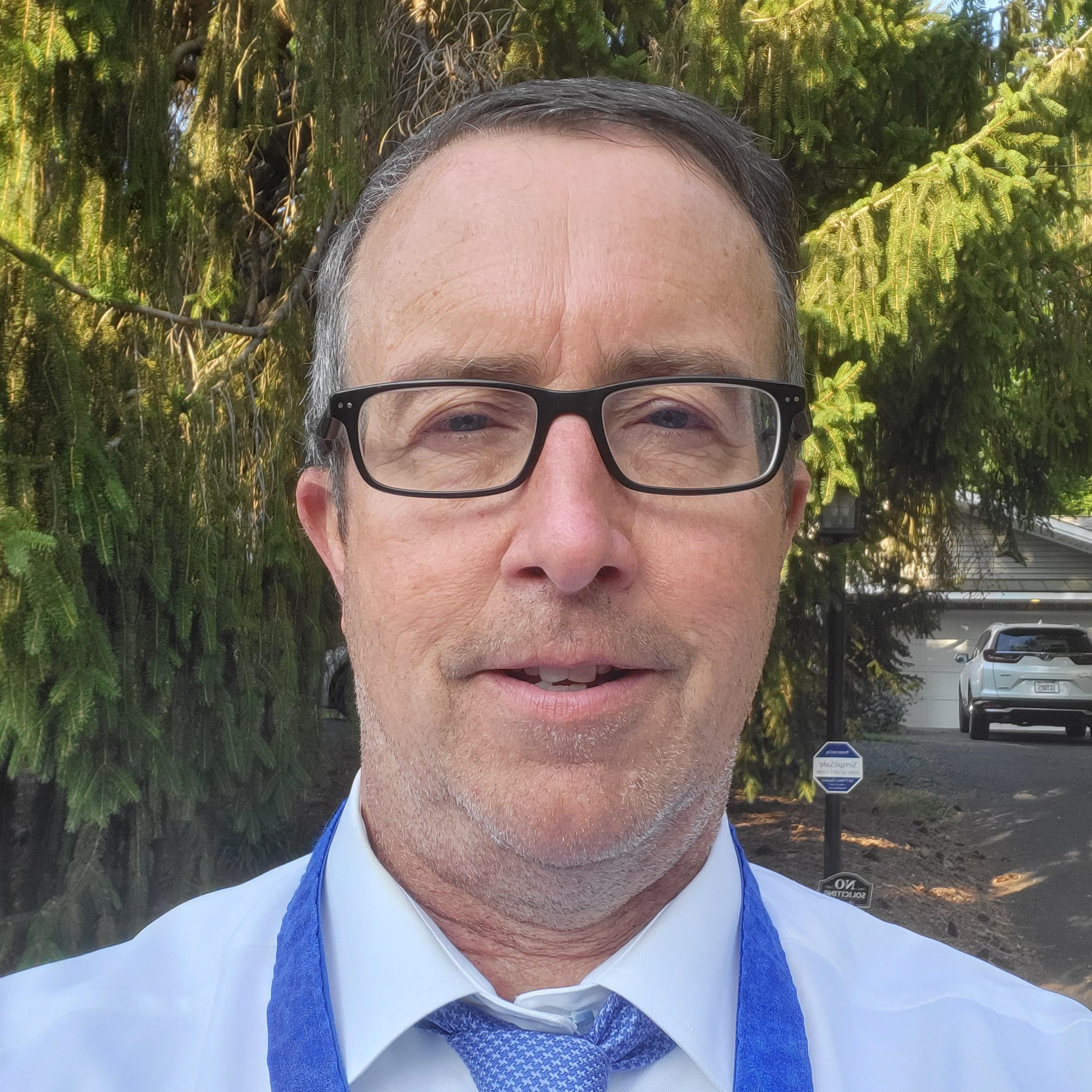
Founder/President and Chief Technology Officer
Bill Kulish is the Founder, President, and Chief Technology Officer of Steelike, Inc., a company at the forefront of advancing construction materials. His significant contributions lie in the creation of Steelike Ultra-High Performance Concrete (UHPC), a material that has garnered attention for its transformative potential in the construction sector.
Bill's expertise in UHPC has earned him recognition and invitations from prominent entities such as the United States Federal Highway Administration, Florida Department of Transportation, Pennsylvania Department of Transportation, Washington D.C. Department of Transportation, American Concrete Institute (ACI), and American Railway Engineering and Maintenance-of-Way Association (AREMA). He is a member of the Organizing Committee and Scientific Subcommittee of the International Interactive Symposium on UHPC, a member of AREMA Technical Committee 8 (Concrete Structures & Foundation), a member of the ACI Committees 134-00(Concrete Constructability), 230-SC (Steering Committee), 230-00 (UHPC), 230C (Structural Design on UHPC), 239-0D (Materials & Methods of Construction on UHPC), 239-0E (Education Outreach), 239-0F (UHPC Sustainability), and 329-00 (Performance Criteria for Ready Mixed Concrete)









